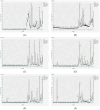Cochlospermum angolense Welw ex Oliv: Phytochemical Profile, Antioxidant Activity, and Therapeutic Prospects
- PMID: 40649281
- PMCID: PMC12251057
- DOI: 10.3390/molecules30132768
Cochlospermum angolense Welw ex Oliv: Phytochemical Profile, Antioxidant Activity, and Therapeutic Prospects
Abstract
The phytochemical investigation and evaluation of the antioxidant activity of the leaves, bark, and roots of Cochlospermum angolense Welw ex Oliv-a valued plant that is widely used in traditional Angolan medicine-hold significant importance. Compounds were extracted from the aforementioned plant using acetone and ethanol and identified by HPLC-ESI-MSn. Both extracts demonstrated notable abilities to scavenge 2,2-diphenyl-1-picrylhydrazyl, nitric oxide, and superoxide radicals, as well as to inhibit lipid peroxidation. A HPLC analysis revealed a diverse array of bioactive compounds, including flavonoids, phenols, alkaloids, quinones, and terpenes, which help neutralize free radicals and protect cells against oxidative stress, thereby contributing to the prevention of various diseases. Moreover, the acetone and ethanol extracts proved to be excellent sources of antioxidants. For the first time, the present study identified new compounds never reported in this species, such as (+)-abscisic acid, angustine B, pinobanksin, dihydrogenistein, (-)-8-prenylnaringenin, isoquercetin, samandarine, dihydromyricetin, and eupatoriocromene, in the leaves, bark, and roots, marking a significant advance in the chemical characterization of C. angolense. These findings enhance our understanding of the bioactive phytochemicals and antioxidant properties of C. angolense and open new avenues for future therapeutic and pharmacological research, further supporting its traditional use in Angolan medicine.
Keywords: Cochlospermum angolense; HPLC-ESI-MSn; antioxidant activity; bark; leaves; roots.
Conflict of interest statement
The authors declare no conflict of interest.
Figures



References
-
- Huntley B.J., Russo V., Lages F., Ferrand N. Biodiversity of Angola: Science & Conservation: A Modern Synthesis. Springer International Publishing; Cham, Switzerland: 2019.
-
- Huntley B.J. Ecology of Angola. Springer International Publishing; Cham, Switzerland: 2023.
-
- Almeida M.Z.d. Plantas Medicinais Mara Zélia de Almeida. 3rd ed. EDUFBA (Editora da Universidade Federal da Bahia); Salvador, Brasil: 2011.
-
- Neto F.G.G., Almeida G.S.S.A., Jesus N.G., Fonseca M.R. Estudo Etnobotânico de plantas medicinais utilizadas pela Comunidade do Sisal no município de Catu, Bahia, Brasil. Rev. Bras. de Plantas Med. 2014;16:856–865. doi: 10.1590/1983-084X/11_207. - DOI
-
- Amaral F.M.M., Ribeiro M.N.S., Barbosa-Filho J.M., Reis A.S., Nascimento F.R.F., Macedo R.O. Plants and chemical constituents with giardicidal activity. Rev. Bras. Farmacogn. 2006;16:696–720. doi: 10.1590/S0102-695X2006000500017. - DOI
MeSH terms
Substances
Grants and funding
LinkOut - more resources
Full Text Sources
Medical
Research Materials
Miscellaneous

